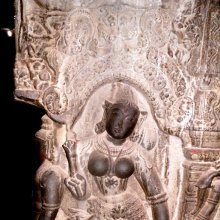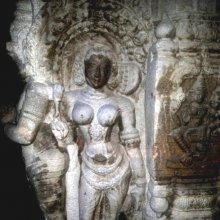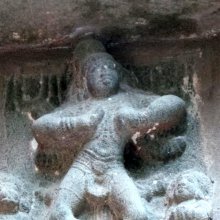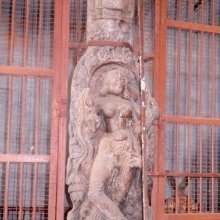Samunnata: 12 definitions
Introduction:
Samunnata means something in Hinduism, Sanskrit, Hindi. If you want to know the exact meaning, history, etymology or English translation of this term then check out the descriptions on this page. Add your comment or reference to a book if you want to contribute to this summary article.
Alternative spellings of this word include Samunnat.
Images (photo gallery)
(+69 more images available)
In Hinduism
Natyashastra (theatrics and dramaturgy)
Source: Wisdom Library: Nāṭya-śāstraSamunnata (समुन्नत, “raised”) refers to a specific gesture (āṅgika) made with the sides (pārśva), according to the Nāṭyaśāstra chapter 10. The sides are one of the six major limbs (aṅga) used to perform certain gestures (āṅgika). These gestures form a part of the histrionic representation (abhinaya).
Source: Shodhganga: Elements of Art and Architecture in the Trtiyakhanda of the Visnudharmottarapurana (natya)Samunnata (समुन्नत) refers to one of the “five kinds of side-movements” (in Sanskrit Dramas), as conveyed through Āṅgikābhinaya: one of the four divisions of Abhinaya or “ways to convey or represent one’s emotion to others”, according to the Viṣṇudharmottarapurāṇa, an ancient Sanskrit text which (being encyclopedic in nature) deals with a variety of cultural topics such as arts, architecture, music, grammar and astronomy.—The āṅgikābhinaya includes the histrionic representation of the limbs which is simply known as physical gestures. There are five kinds of side movements accepted in the Viṣṇudharmottarapurāṇa. Samunnata movement should be adopted to show retreat. In the Nāṭyaśāstra, the side movement called unnata is mentioned which suggests the position of going backward. The side movement called samunnata is not accepted in the Nāṭyaśāstra.

Natyashastra (नाट्यशास्त्र, nāṭyaśāstra) refers to both the ancient Indian tradition (shastra) of performing arts, (natya—theatrics, drama, dance, music), as well as the name of a Sanskrit work dealing with these subjects. It also teaches the rules for composing Dramatic plays (nataka), construction and performance of Theater, and Poetic works (kavya).
Shaktism (Shakta philosophy)
Source: Google Books: ManthanabhairavatantramSamunnata (समुन्नत) refers to “upraised (breasts)”, according to the Kulakaulinīmata 5.88-99.—Accordingly, “The goddess (Tripurabhairavī) is red like vermillion and the Bandhūka flower. She wears red clothes and is adorned with all the ornaments. She has matted hair and, peaceful, the moon is her crest jewel. She is replete with all (auspicious) characteristics and sits on a cot. She has large, round and upraised breasts [i.e., samunnata-payodharā], her navel has three folds, and she is adorned with (a fine) line of hair (travelling down from it). [...]”.

Shakta (शाक्त, śākta) or Shaktism (śāktism) represents a tradition of Hinduism where the Goddess (Devi) is revered and worshipped. Shakta literature includes a range of scriptures, including various Agamas and Tantras, although its roots may be traced back to the Vedas.
Languages of India and abroad
Sanskrit dictionary
Source: DDSA: The practical Sanskrit-English dictionarySamunnata (समुन्नत).—p. p.
1) Upraised, lifted up.
2) Elevated, high, lofty.
3) Exalted, sublime.
4) Proud.
5) Projecting.
6) Upright, just.
7) Arched, vaulted.
Source: Cologne Digital Sanskrit Dictionaries: Shabda-Sagara Sanskrit-English DictionarySamunnata (समुन्नत).—mfn.
(-taḥ-tā-taṃ) 1. High, lofty, elevated. 2. Full, prominent. 3. Exalted, dignified. 4. Proud, arrogant. 5. Lifted up, raised up. 6. Just, upright. E. sam and ud before nam to bow, aff. kta .
Source: Cologne Digital Sanskrit Dictionaries: Cappeller Sanskrit-English DictionarySamunnata (समुन्नत).—[adjective] lifted up, risen; prominent, projecting; high, sublime.
Source: Cologne Digital Sanskrit Dictionaries: Monier-Williams Sanskrit-English Dictionary1) Samunnata (समुन्नत):—[=sam-unnata] [from samun-nam] mfn. risen up, lifted up, raised aloft, [Kāvya literature]
2) [v.s. ...] arched, vaulted, [Varāha-mihira’s Bṛhat-saṃhitā; Rājataraṅgiṇī]
3) [v.s. ...] high, sublime, [Kāmandakīya-nītisāra]
4) [v.s. ...] proud, arrogant, [Horace H. Wilson]
Source: Cologne Digital Sanskrit Dictionaries: Yates Sanskrit-English DictionarySamunnata (समुन्नत):—[samu-nnata] (taḥ-tā-taṃ) a. High, exalted; prominent; proud.
Source: DDSA: Paia-sadda-mahannavo; a comprehensive Prakrit Hindi dictionary (S)Samunnata (समुन्नत) in the Sanskrit language is related to the Prakrit word: Samunnaya.
Sanskrit, also spelled संस्कृतम् (saṃskṛtam), is an ancient language of India commonly seen as the grandmother of the Indo-European language family (even English!). Closely allied with Prakrit and Pali, Sanskrit is more exhaustive in both grammar and terms and has the most extensive collection of literature in the world, greatly surpassing its sister-languages Greek and Latin.
Hindi dictionary
Source: DDSA: A practical Hindi-English dictionarySamunnata (समुन्नत) [Also spelled samunnat]:—(a) risen, elevated; progressed, developed; ~[tā] progress, development; elevation, rise; hence —[yana] (nm).
...
Kannada-English dictionary
Source: Alar: Kannada-English corpusSamunnata (ಸಮುನ್ನತ):—
1) [adjective] very tall; lofty.
2) [adjective] raised up; elevated.
3) [adjective] superior; excellent.
Kannada is a Dravidian language (as opposed to the Indo-European language family) mainly spoken in the southwestern region of India.
Nepali dictionary
Source: unoes: Nepali-English DictionarySamunnata (समुन्नत):—adj. 1. upraised; lifted; 2. elevated; high; lofty; 3. exalted; sublime; 4. proud; haughty; 5. projecting; 6. upright; just;
Nepali is the primary language of the Nepalese people counting almost 20 million native speakers. The country of Nepal is situated in the Himalaya mountain range to the north of India.
See also (Relevant definitions)
Partial matches: Samu, Sam, Unnata, Camu.
Starts with: Samunnatalangula.
Full-text: Samunnat, Samunnatalangula, Samunnaya, Samunnati, Parshva, Retreat, Side, Nam.
Relevant text
Search found 6 books and stories containing Samunnata, Sam-unnata, Samu-nnata; (plurals include: Samunnatas, unnatas, nnatas). You can also click to the full overview containing English textual excerpts. Below are direct links for the most relevant articles:
Garga Samhita (English) (by Danavir Goswami)
Verse 3.9.37 < [Chapter 9 - The Birth of Śrī Girirāja]
Vishnudharmottara Purana (Art and Architecture) (by Bhagyashree Sarma)
1.3. Elements of Drama (c): Bodily Movements < [Chapter 3 - Drama and Dance]
Ramayana of Valmiki (by Hari Prasad Shastri)
Chapter 58 - The Death of Prahasta < [Book 6 - Yuddha-kanda]
Gati in Theory and Practice (by Dr. Sujatha Mohan)
Gati in vehicles < [Chapter 3 - Application of gati in Dṛśya-kāvyas]
Relevant Sthānas and Nyāyas related to perform the Gati < [Chapter 2 - Concept and technique of Gati]
Gati performed in Nṛtta < [Chapter 3 - Application of gati in Dṛśya-kāvyas]
Natyashastra (English) (by Bharata-muni)
The Matsya Purana (critical study) (by Kushal Kalita)
Part 1 - Use of Chandas (metres) in the Matsyapurāṇa < [Chapter 2 - Literary aspect of the Matsyapurāṇa]





